Literacy: India
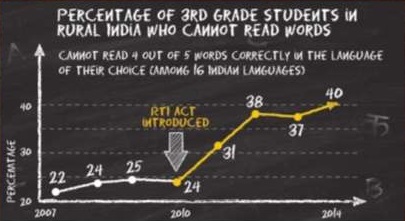
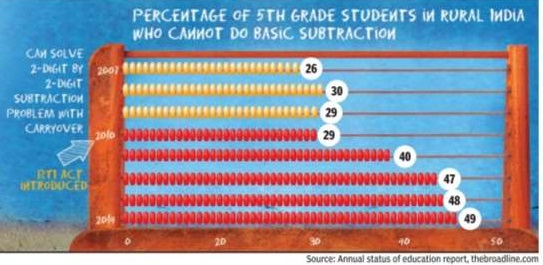
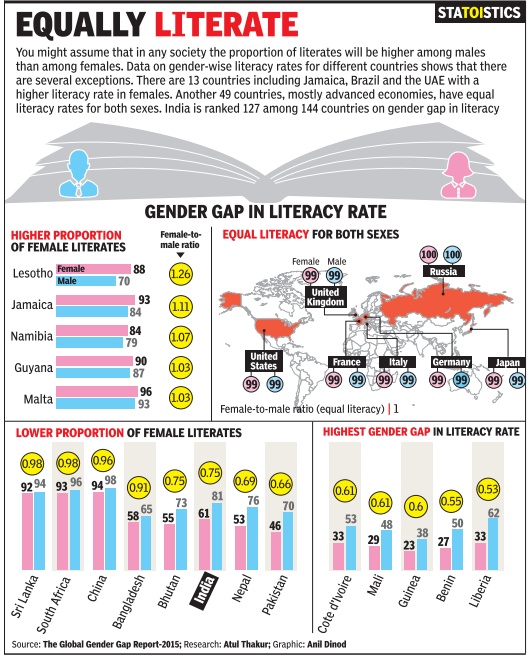
This is a collection of articles archived for the excellence of their content. Readers will be able to edit existing articles and post new articles directly |
Contents |
Statistics, state-wise
State-wise literacy, 1951-2001
Source: India Budget.nic.in
|
States/Union Territories |
1951 |
1961 |
1971 |
1981 |
1991 |
2001 |
|
Andaman & Nicobar Islands |
30.30 |
40.07 |
51.15 |
63.19 |
73.02 |
81.30 |
|
Andhra Pradesh |
– |
21.19 |
24.57 |
35.66 |
44.08 |
60.47 |
|
Arunachal Pradesh |
NA |
7.13 |
11.29 |
25.55 |
41.59 |
54.34 |
|
Assam |
18.53 |
32.95 |
33.94 |
– |
52.89 |
63.25 |
|
Bihar |
13.49 |
21.95 |
23.17 |
32.32 |
37.49 |
47.00 |
|
Chandigarh |
– |
NA |
70.43 |
74.80 |
77.81 |
81.94 |
|
Chhattisgarh |
9.41 |
18.14 |
24.08 |
32.63 |
42.91 |
64.66 |
|
Dadra & Nagar Haveli |
– |
– |
18.13 |
32.90 |
40.71 |
57.63 |
|
Daman & Diu |
– |
– |
– |
– |
71.20 |
78.18 |
|
Delhi |
NA |
61.95 |
65.08 |
71.94 |
75.29 |
81.67 |
|
Goa |
23.48 |
35.41 |
51.96 |
65.71 |
75.51 |
82.01 |
|
Gujarat |
21.82 |
31.47 |
36.95 |
44.92 |
61.29 |
69.14 |
|
Haryana |
– |
– |
25.71 |
37.13 |
55.85 |
67.91 |
|
Himachal Pradesh |
–––– |
|
|
|
63.86 |
76.48 |
|
Jammu & Kashmir |
– |
12.95 |
21.71 |
30.64 |
NA |
55.52 |
|
Jharkhand |
12.93 |
21.14 |
23.87 |
35.03 |
41.39 |
53.56 |
|
Karnataka |
– |
29.80 |
36.83 |
46.21 |
56.04 |
66.64 |
|
Kerala |
47.18 |
55.08 |
69.75 |
78.85 |
89.81 |
90.86 |
|
Lakshadweep |
15.23 |
27.15 |
51.76 |
68.42 |
81.78 |
86.66 |
|
Madhya Pradesh |
13.16 |
21.41 |
27.27 |
38.63 |
44.67 |
63.74 |
|
Maharashtra |
27.91 |
35.08 |
45.77 |
57.24 |
64.87 |
76.88 |
|
Manipur2 |
12.57 |
36.04 |
38.47 |
49.66 |
59.89 |
70.53 |
|
Meghalaya |
NA |
26.92 |
29.49 |
42.05 |
49.10 |
62.56 |
|
Mizoram |
31.14 |
44.01 |
53.80 |
59.88 |
82.26 |
88.80 |
|
Nagaland |
10.52 |
21.95 |
33.78 |
50.28 |
61.65 |
66.59 |
|
Orissa |
15.80 |
21.66 |
26.18 |
33.62 |
49.09 |
63.08 |
|
Pondicherry |
– |
43.65 |
53.38 |
65.14 |
74.74 |
81.24 |
|
Punjab |
– |
NA |
34.12 |
43.37 |
58.51 |
69.65 |
|
Rajasthan |
8.5 |
18.12 |
22.57 |
30.11 |
38.55 |
60.41 |
|
Sikkim |
– |
– |
17.74 |
34.05 |
56.94 |
68.81 |
|
Tamil Nadu |
|
36.39 |
45.40 |
54.39 |
62.66 |
73.45 |
|
Tripura |
NA |
20.24 |
30.98 |
50.10 |
60.44 |
73.19 |
|
Uttar Pradesh |
12.02 |
20.87 |
23.99 |
32.65 |
40.71 |
56.27 |
|
Uttarakhand |
18.93 |
18.05 |
33.26 |
46.06 |
57.75 |
71.62 |
|
West Bengal |
24.61 |
34.46 |
38.86 |
48.65 |
57.70 |
68.64 |
|
ALL INDIA2 |
18.33 |
28.30 |
34.45 |
43.57 |
52.21 |
64.84 |
Notes
1. Literacy rates for 1951, 1961 and 1971 Censuses relate to population aged five years and above. The rates for the 1981, 1991 and 2001 Censuses relate to the population aged seven years and above. The literacy rate for 1951 in case of West Bengal relates to Total population including 0-4 age group. Literacy rate for 1951 in respect of Chhatisgarg, Madhya Pradesh and Manipur are based on sample population.
2. India and Manipur figures exclude those of the three sub-divisions viz. Mao Maram, Paomata and Purul of Senapati district of Manipur as census results of 2001 in these three sub-divisions were cancelled due to technical and administrative reasons.
3. N.A. - Not available as no census was carried out in Assam during 1981 and in Jammu & Kashmir during 1991.
4. Created in 2001. Uttaranchal Pradesh, Jharkhand and Chattisgarh for 1981 and 1991 are included under Uttar Pradesh, Bihar and Madhya Pradesh respectively.
Source: Office of the Registrar General, India
State-wise literacy, 1951
|
Rank in 1951 |
State/Union Territory |
Percentage of literates |
|
1. |
Kerala |
47.18 |
|
2. |
Mizoram |
31.14 |
|
3. |
Andaman & Nicobar Islands |
30.30 |
|
4. |
Maharashtra |
27.91 |
|
5. |
West Bengal |
24.61 |
|
6. |
Goa |
23.48 |
|
7. |
Gujarat |
21.82 |
|
8. |
Uttarakhand |
18.93 |
|
9. |
Assam |
18.53 |
|
|
ALL INDIA |
18.33 |
|
10. |
Orissa |
15.80 |
|
11. |
Lakshadweep |
15.23 |
|
12. |
Bihar |
13.49 |
|
13. |
Madhya Pradesh |
13.16 |
|
14. |
Jharkhand |
12.93 |
|
15. |
Manipur |
12.57 |
|
16. |
Uttar Pradesh |
12.02 |
|
17. |
Nagaland |
10.52 |
|
18. |
Chhattisgarh |
9.41 |
|
19. |
Rajasthan |
8.5 |
|
|
ALL INDIA |
18.33 |
State-wise literacy, 2011
Source: Census 2011
|
Rank in 2011 |
State/ UT |
Literacy %age |
|
1. |
Kerala |
94.00 |
|
2. |
Lakshadweep |
91.85 |
|
3. |
Mizoram |
91.33 |
|
4. |
Goa |
88.70 |
|
5. |
Tripura |
87.22 |
|
6. |
Daman and Diu |
87.10 |
|
7. |
Andaman and Nicobar Islands |
86.63 |
|
8. |
Delhi |
86.21 |
|
9. |
Chandigarh |
86.05 |
|
10. |
Puducherry |
85.85 |
|
11. |
Himachal Pradesh |
82.80 |
|
12. |
Maharashtra |
82.34 |
|
13. |
Sikkim |
81.42 |
|
14. |
Tamil Nadu |
80.09 |
|
15. |
Nagaland |
79.55 |
|
16. |
Uttarakhand |
78.82 |
|
17. |
Gujarat |
78.03 |
|
18. |
Manipur |
76.94 |
|
19. |
West Bengal |
76.26 |
|
20. |
Dadra and Nagar Haveli |
76.24 |
|
21. |
Punjab |
75.84 |
|
22. |
Haryana |
75.55 |
|
23. |
Karnataka |
75.36 |
|
24. |
Meghalaya |
74.43 |
|
|
India |
74.04 |
|
25. |
Orissa |
72.87 |
|
26. |
Assam |
72.19 |
|
27. |
Chhattisgarh |
70.28 |
|
28. |
Madhya Pradesh |
69.32 |
|
29. |
Uttar Pradesh |
67.68 |
|
30. |
Jammu and Kashmir |
67.16 |
|
31. |
Andhra Pradesh |
67.02 |
|
32. |
Jharkhand |
66.41 |
|
33. |
Rajasthan |
66.11 |
|
34. |
Arunachal Pradesh |
65.38 |
|
35. |
Bihar |
61.80 |
|
|
India |
74.04 |
Statistics, year-wise
Literacy in 2006
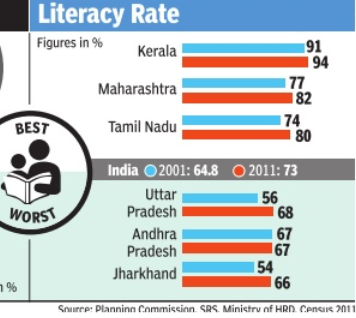
India has 37% of world's illiterate adults
IANS| Jan 29, 2014
India has by far the largest population of illiterate adults — 287 million or 37 per cent of the global total, according to the "EFA Global Monitoring Report, 2013-14: Teaching and Learning: Achieving quality for All." Commissioned by Unesco, it said that 10 countries (including India) account for 557 million or 72 per cent of the global population of illiterate adults.
"India's literacy rate rose from 48 per cent in 1991 to 63 per cent in 2006, (the latest year for which data was available), but population growth cancelled the gains. So there was no change in the number of illiterate adults," the report said.
Though India has more than 99 per cent children in schools because of the Right to Education Act, the quality of education being imparted is a big challenge that should be addressed, a top Unesco officer said.
The report also said that a global learning crisis was costing governments $129 billion a year, and that 10 per cent of global spending on primary education was being lost on poor quality education that was failing to ensure that children learn.
"It leaves one in four young people in poor countries unable to read a single sentence, affecting one-third of young women in South and West Asia," it said.
The countries include Bhutan, India, Bangladesh, Sri Lanka and Afghanistan.
2011: Literacy rate 74.4%
The Times of India, January 28, 2016
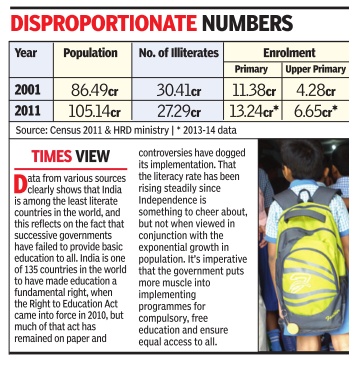
Chethan Kumar Literacy rate up, but so is illiteracy
Population Rising But Enrolment Not Keeping Pace
The overall literacy rate in the country may have gone up to 74.4%, but the drop in the illiteracy rate has not matched the increase in population. Between 2001 and 2011, the population above the age of 7 grew by 18.65 crore but the decrease in the number of illiterates is just 3.11 crore.
A 2015 Unesco report said that in terms of absolute numbers, India -with 28.7 crore illiterates -was the country with the largest number of adults without basic literacy skills in 2010-11 compared to 2000-01 when it had 30.4 crore illiterates. The fact that illiteracy is not being tackled is evident from the enrolment rates in primary and upper primary schools. Over 12 years (2000-01 to 2013-14), the number of children who enrolled in primary schools increased by just 1.86 crore, and at the upper primary level by just over 2 crore.The population during this period, however, increased by more than 18 crore.
“Over the past few years, there has been a dip in the enrolment rate across the country compared to the growth in population,“ says A S Seetharamu, a former professor of the Institute of Social and Economic Change.
Going by 2011 Census data, most states, barring a few like Nagaland, have recorded an increase in population but the enrolment rate does not mirror that. The country also seems to be having a problem with retaining people in schools and colleges. An average of 326 out of 1,000 students in rural areas are dropping out, while the same is 383 per 1,000 in urban areas, the National Sample Survey Organisation's (NSSO) last survey reveals. This data counts people up to the age of 29.
UNESCO has put the number of out-of-school (OOS) children at 17 lakh in India.A survey commissioned by the Centre put the number for 2014 at 61lakh, with SC and ST children making up 49.03% (29.73 lakh) of these.
2011: the most and least literate states
See graphic. : Literary rate, 2011, Bihar and Kerala and other states having highest and lowest adult literacy, respectively, 2011
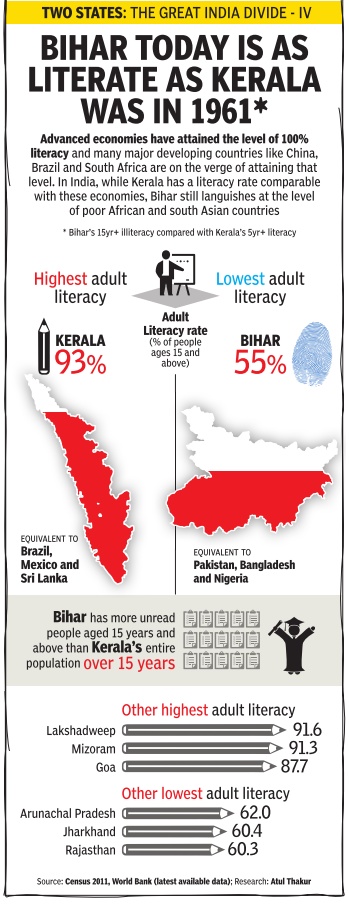
2017: Literacy rate, youth
See graphic: Youth Literacy Rate as in August 2017
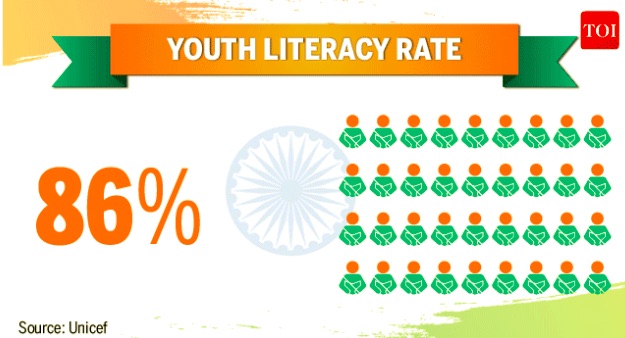
Statistics, India and the world
2015: India 2nd most `ignorant' among 33 nations
The Times of India, Dec 07 2015
India 2nd most `ignorant' nation, Mexico 1st: Study
India has the dubious honour of being the second most ignorant nation in the world after Mexico, according to a survey which posed questions on issues like inequality , non-religious population, female employment and internet access. The survey conducted by Ipsos MORI, a London-based market research firm, polled 25,000 people from 33 countries and found that while people “overestimate what we worry about“, a lot of major issues are underestimated.
“Mexico and India receive the dubious honour of being the most inaccurate in their perceptions on these issues, while South Koreans are the most accurate, followed by the Irish,“ the survey said.
The rankings of the nations were based on the “index of ignorance“ which was determined by questions about wealth that the top 1% own, obesity , non-religious population, immigration, living with parents, female employment, rural living and internet access.
Most Indians “underestimate“ how much of the country's wealth is concentrated in the hands of the top 1%, the survey said, adding that the top 1% actually own an “incredible“ 70% of all wealth.
The survey also found that most Indians “hugely overestimate“ the proportions of non-religious people in the country to be 33% when the true figure is under 1%.
While Israel significantly underestimates the proportion of female employment (by 29 percentage points), people in countries like India, Mexico, South Africa and Chile all think of more women in work than really are, it said.India fell in the list of nations which overestimate representation by women in politics.
Countries like Columbia, Russia, India and Brazil all think there is better female representation than there really is, the survey said.
However, the Indian population seriously underestimates the rural population of the country and thinks more people have internet access than in reality .
In India, the average guess among online respondents for internet access is 60% -an overestimation of the true picture of 41 percentage points, the survey added.